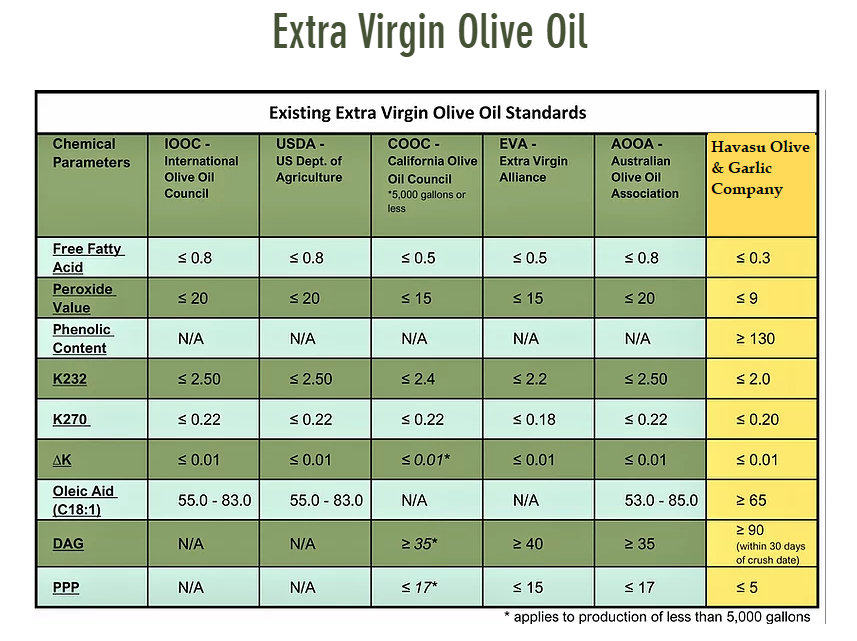No products in the cart.
Jul 20, 2025Chicken Enchilada Dip


Free Fatty Acids – FFA
Free Fatty Acid (FFA) indicates the condition of the olives at time of crush! Healthy fruit processed immediately should produce oil with low FFA! The lower, the better! An oil with a low (FFA) will have a higher smoke point than an oil with a higher FFA. The IOC requires that this number be below 0.8 in order for an olive oil to be considered Extra Virgin grade. Our standards at Havasu Olive & Garlic Company exceed those of existing standards. Our FFA is always lower than 0.3!
Peroxide Value – PV
This number must be equal to or less than 20. This is the primary measurement of the rancidity of a particular Extra Virgin Olive Oil (EVOO). Peroxide value is affected by procedures used in processing and storing of the oil. Peroxide is responsible for color and aroma changes as the oil oxidizes. Again, our standards at Havasu Olive & Garlic Company will always exceed existing standards. In that regard, we like to keep our Peroxide Value under 9!
Oleic Acid
Oleic Acid- A higher level is better! Oleic acid is responsible for some of the health benefits of EVOO, and its high resistance to free radicals helps to slow down the spread of damaging chemical chain-reactions. Because of its high degree of resistance to attack by oxygen free radicals, higher levels of oleic acid in an olive oil help keep it fresher for longer, by preventing the formation of peroxidized (rancid) fats.
Biophenols
The term “biophenols” was first coined by Romeo and Ucculle in 1996 to denote bioactive phenols in olives replacing the more common and less chemically accurate term “polyphenols.” “Biophenols” has started gaining popularity beyond olive oil chemistry and currently used by researchers to refer to plant phenols in general.
As science developed, we have learned that a significant amount of health attributes related to Extra Virgin Olive Oil are not only linked to its profile rich in monounsaturated fatty acids but also to its biophenol content. Biophenols are very effective antioxidants in olive oil and contribute significantly to oxidative stability, shelf life and health claims. There are typically more than 20 different biophenols in Extra Virgin Olive Oil.
Phenols
Antioxidant like substances that are naturally occurring in Extra Virgin Olive Oils. Phenols extend the shelf-life of Extra Virgin Olive Oil & also determine the “style” in terms of bitterness and pungency. Generally, when an oil has a high phenol count (presented in parts per million), it will have more “pepper” or more “bitterness”. Many consider phenols to be free-radical “scavengers”.
DAGs (Diacylglycerols)
DAGs are always reported & presented in the1,2 ratio (as a percentage of total DAGs) as the oil ages, the 1,2 DAGs are transformed to 1,3 DAGs. Fresh Olive Oil made from sound fruit should result in a DAG content of 85% or higher whereas the processing of rotten and or fermented olives will produce fresh oil with low DAGs indicating a very short shelf-life. DAGs typically drop between 20-30% per year depending on storage conditions and FFA. They are highly influenced by heat but not light.
(PPP) Pyropheophytin A
Freshly made oil should have a PPP of close to zero. PPP are highly influenced by heat and then also by light. In ideal storage conditions, they should only increase between 6-8% per year! An oil with an extremely high PPP is a clear indication that “something” is wrong or amiss. Either the oil is severely aged, deodorized or has had continuous light exposure (clear packaging!) for extended time periods and/or higher than normal storage temperatures.
A-Tocopherals
A nutrient that the body needs in small amounts to stay healthy and work the way it should. It is fat-soluble (can dissolve in fats and oils) and is found in seeds, nuts, leafy green vegetables, and vegetable oils. Alpha-tocopherol boosts the immune system and helps keep blood clots from forming. It also helps prevent cell damage caused by free radicals (highly reactive chemicals). Alpha-tocopherol is being studied in the prevention and treatment of some types of cancer. It is a type of antioxidant. Also called vitamin E.
Squalene
Squalene is a natural organic compound which is part of our tissues. It is a polyunsaturated hydrocarbon; its molecular structure resembles that of vitamin E. However, Squalene contains four additional groups of isoprenoids, which are very potent natural antioxidants.
No products in the cart.
